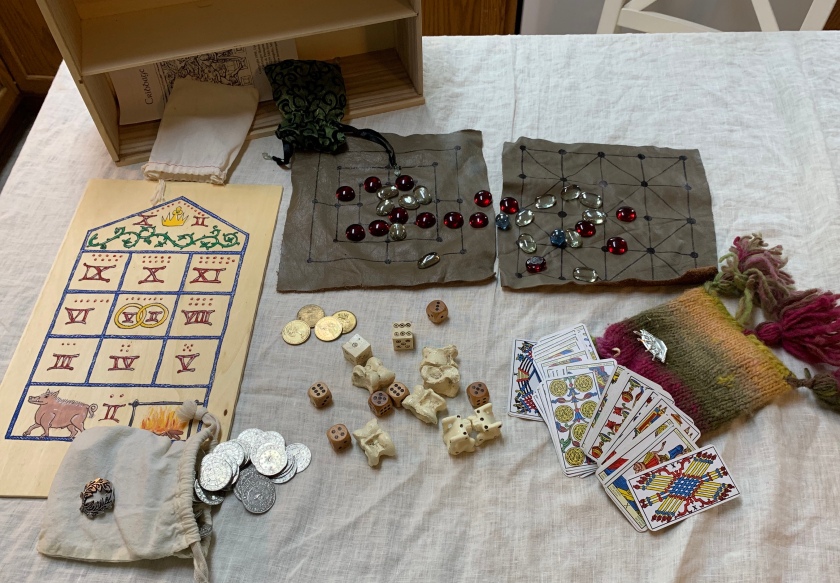
The SCA is not a spectator sport, you have to make your own fun. I am not much of a gamer in modern life, but I love having historical games to play at events. I have collected some of my favorites in a box (see previous post for information about the painted Glückhaus board on the lid!) — Nine Men’s Morris, Alquerque (the ancestor of checkers), knucklebones, assorted dice, and a tarot deck, plus tokens and such for game play and pouches to store things in.
Here’s a photo of the full collection all spread out:

There are lots of resources online about medieval and renaissance games — I really like this simple yet comprehensive guide that includes ball games, running games, throwing games, board games, card games, dice games… lots of games! The best way to find out what games you like to play is to play some, so I suggest you either make/buy yourself some stuff to get you started or find games to join at events to see what strikes your fancy.
To create a general-purpose historical games set, you’ll need:
- Game boards that are easy to roll up and transport (so, sewn/drawn/painted on cloth or leather)
- Dice
- Knucklebones (either the real deal or resin replicas)
- Flat marbles, colorful stones, wooden pieces, or other markers in at least two colors
- Replica coins or other tokens to gamble with
- Card decks
There’s a great online resource for all manner of historical games, MacGregor Historic Games. This is where I got my dice sets and knucklebones, and they also sell instruction booklets and some coins/tokens. I also found a set of tiny bone dice and weirdly colorful knucklebones while I was hunting for game supplies on Amazon, but I can’t personally vouch for them.
I made the nine men’s morris and alquerque boards the better part of a decade ago with some scrap leather, a ruler, and a permanent marker. To make your own, find some smooth, garment-weight leather pieces big enough to be worth using (I think mine are about 8 inches square), look up images of the game boards you want to make, measure and mark. For playing pieces, flat marbles are easy or get some wood discs and paint / mark them. Or go historical and gather some pebbles 🙂
When it comes to card games, I really, really like tarocchi / tarock / triumph / tarot. You can learn more about how to play and the history of tarot cards on Wikipedia. (As an aside, do I lose all credibility forever by admitting that I think Wikipedia is a great resource for stuff like this? I wouldn’t use it as documentation for an A&S championship, but to quickly learn a little about a topic it can’t be beat. I digress.) My personal preference is to use a Tarot de Marseilles deck, as it has a historical look and doesn’t have the “occult” connotation that many modern people associate with tarot decks. I also like the mini version, as it’s easier to hold the cards (and keep them secret!) during game play.
I recommend getting some pouches to keep everything organized. I personally like the inexpensive muslin ones that they sell for things like wedding favors, because then when I inevitably lose a few it’s not a big deal. Plus, I always need more tiny bags.
One thing that’s been challenging for me to find for my games box was coins or tokens to use for gambling games that weren’t terribly expensive and looked at least passably historical. I’ve played a lot of rounds of Glückshaus with standard modern pennies, honestly, because the price can’t be beaten. I have some replica groats that I purchased when I got laureled, but now the maker seems to not have his site up anymore so I can’t send you to him. One option that I’m considering are some replica “dubloons” — I suppose I could call them gold marks, but the idea of gambling with gold marks is OUTRAGEOUS from a historical perspective; nobody has that kind of money! But look how shiny they are, and 19 bucks for 50 coins is about the best price you’ll find.
Hopefully this is enough to get you started assembling your own set of games. These are all “indoor” games, of course; I’m working on making some equipment for simple outdoor games like quoits and battledore, and you can probably look forward to posts about those as I get them finished.


One inexpensive (though requiring some logistics) gaming coins is English pennies and tuppence.
The have a Queen Elizabeth on one side and the gate of the tower of London on the other, so not jarringly out of period.
The trick is asking someone traveling there to acquire them and haul them back.
LikeLike